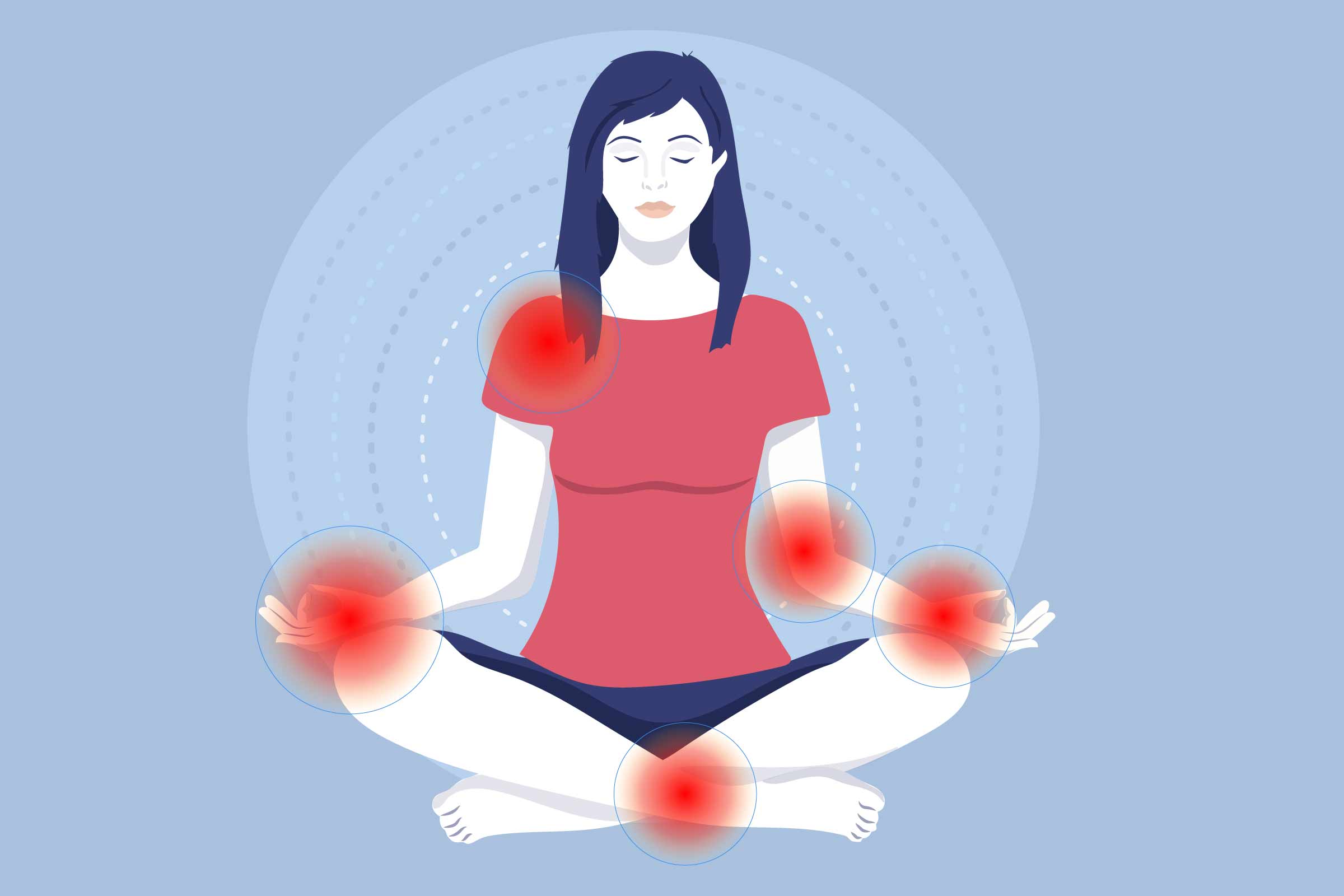Mindfulness meditation is a powerful tool to help manage pain. It can be used in combination with psychotherapy and other non-pharmacological treatment strategies.
MRI brain scans show that experienced meditators are less sensitive to pain. This is because of changes in the brain’s default mode network.
Start by lying down in a comfortable position, close your eyes and focus on the sensations in your body, including any pain.
Understanding Mindfulness Meditation
Mindfulness meditation involves focusing on the present moment while observing and accepting thoughts and feelings without judgment. It promotes self-acceptance to reduce suffering and improve quality of life. It also helps to lower the body’s stress response, which can make many other health conditions worse.
Studies show that mindfulness meditation has a significant effect on pain and associated symptoms. Unlike placebo effects, these results are real. In fact, some studies have even used brain imaging to demonstrate that meditation impacts the sensitivity and perception of pain.
Adding mindfulness meditation to your treatment regimen can be as simple as incorporating breathing techniques into your daily routine or gradually scanning your body, starting with your toes and moving up. You can also incorporate movement and yoga or try a mantra-based practice like chanting or repeating a word.
Various types of mindfulness meditation are available, and the best way to learn is to find a qualified teacher who specializes in mindfulness-based stress reduction. A specialized program can consist of weekly group sessions, instruction and recordings for at-home practices.
Mind-Body Connection in Chronic Pain
The mind-body connection is a key element to healing and managing pain. Mindfulness meditation can help people relax and calm their body, which can reduce the sensations of pain. It also helps people learn to accept their pain rather than fight it. This is the best way to deal with chronic pain.
A study published in Psychiatric Services found that mindfulness practice resulted in greater improvements in quality of life and depression, which is often associated with pain, than other treatments. Additionally, mindfulness meditation can improve sleep, which is essential for people with chronic pain.
Mindfulness meditation has been shown to reduce pain by activating a different neural pathway than a placebo. A brain scan of experienced meditators has shown that their brains respond differently to pain.
When you’re in pain, try visualizing a safe-place, like the beach or a forest, to help you shift your focus. You can even listen to a guided visualization meditation on our Daily Calm app. If you’re not sure where to start, check out these free resources for beginners and experts.
Breath Awareness Techniques
One of the easiest mindfulness practices for pain management is to focus on the breath. Breath awareness meditation is simple and can be done anywhere, anytime. It can also be an entry point to a more comprehensive practice of mindfulness that can help you learn how to accept and deal with your emotions.
A recent study found that people who were experienced in mindful breathing had less sensitive pain, as measured by MRI brain scans. Researchers believe that this is because the meditation increases functional connectivity in frontal regions of the brain, which focus on internal sensory details called interoception and can compete with external pain signals to inhibit processing in somatosensory cortex.
Another technique to try is visualization meditation, which involves imagining a calm place or situation. You can do this in your home, on a hiking trail, or in a relaxing spa. The important thing is to find a place that makes you feel comfortable and safe. Studies have shown that visualizing a safe place can decrease stress and increase pain tolerance.
Body Scan Meditation
Body scan meditation is a mindfulness practice that involves sweeping one’s attention over the body in a systematic way. It is a form of deep relaxation, and it helps to identify areas where stress or pain may be located.
You can do this while lying down or sitting in a comfortable position. You can start with just a few minutes, and then increase your time as you become more comfortable with the practice. You can use meditation apps, podcasts or guided videos to help you through the process.
During a body scan, it is important to pay close attention to how your body feels at each moment. If you notice a sensation that is unpleasant, such as pain or tension, try to accept it for what it is instead of fighting against it.
Mindfulness practice can be a powerful tool for chronic pain management, but it’s important to work with your healthcare provider on how to incorporate it into your daily routine. Remember to be patient and compassionate with yourself, as developing a mindfulness practice can take time.
Non-Judgmental Observation of Sensations
The non-judgmental observation of sensations, such as breathing, movement and touch is a key practice in mindfulness meditation. It allows individuals to be aware of their feelings without getting caught up in negative thoughts, such as those associated with pain.
A recent study of mindfulness and the brain showed that long-term meditation can actually change the structure of the brain in areas involved with assessing pain. This makes individuals less sensitive to pain.
Another way that meditation can help with chronic pain is by reducing the tendency to catastrophize, which is the belief that a negative event will be catastrophic or disastrous. Many people who live with chronic pain develop a habit of catastrophizing, which can have a devastating effect on their quality of life. Meditation can help people who are catastrophizing learn to observe their negative thoughts and feelings, but to not engage with them.
To try this, find a comfortable position lying down and focus on your breath, feeling your belly rise as you inhale and recede as you exhale. Then, place your attention on the bottom of your left foot and notice any sensations you are experiencing, including any pain.
Mindful Movement and Yoga
Mindful movement meditation is a great option for anyone who has difficulty sitting or focusing on one activity. It involves tuning into the body and noticing sensations of moving—whether that’s the feel of your hands on the water while swimming, or the up-and-down repetition of running or weight lifting.
Yoga is often used for mindful movement meditation because of its connection to breathing and the body, but you don’t need to be a yoga enthusiast to enjoy the benefits. Simply incorporating movements into your daily routine and concentrating on the body’s natural rhythm can help relieve pain by increasing tolerance for it.
Researchers have also found that mindfulness reduces pain by altering the processing of nociceptive information in the brain, which can be measured using fMRI imaging. The deactivation of a particular node in the default mode network during meditation appears to play an important role in this effect.
Building a Sustainable Mindfulness Practice
While a mindfulness practice may be hard for some, it can help reduce chronic pain and improve functioning. Practicing the techniques can help people avoid maladaptive behaviors such as hypervigilance (constant awareness of pain) and fear avoidance (avoiding situations that they think will increase their pain). These behaviors lead to increased stress and reduce function, making the pain worse.
Mindfulness meditation interrupts the pain signals from the body by disrupting the connection between brain areas that produce the sensation of pain and those that provide a sense of self. The result is that the sensation of pain still occurs but feels less intense.
A variety of apps and online resources are available to guide people in their mindfulness practice. For example, the Headspace app provides guidance for visualization meditation and offers a free guided audio session. It is important to start small and build your practice over time. Initially, the mind will wander during meditation, but it is important to gently bring the attention back to the breath. This will become easier over time.
Conclusion
A growing body of clinical research supports the efficacy of mindfulness meditation in reducing pain intensity and improving mood and quality of life. Several meta-analyses have shown that mindfulness meditation is effective for chronic pain conditions, including back pain, fibromyalgia, and somatization disorders. Moreover, this form of meditation is a non-pharmacological approach to pain management with minimal risk of side effects.
Activation of the orbitofrontal cortex (OFC) and anterior cingulate cortex during meditation may facilitate inhibitory connections in the thalamic reticular nuclei to essentially “close the gate” on ascending nociceptive information.45 In addition, meditators have reduced thalamic activity and increased connectivity of the dlPFC, which is associated with cognitive control.
Several studies also show that meditation increases serotonin and norepinephrine levels, which are neurotransmitters linked to the reduction of pain intensity. In addition, meditation reduces inflammatory cytokines such as interleukin-6 and tumor necrosis factor-alpha. These cytokines are known to increase the feeling of pain. Thus, it is not surprising that many patients seek non-pharmacological pain treatments. In addition, long-term meditation can change the structure of the brain, making it less sensitive to pain.

